"Buboes, phlegm, blood and guts! Boils, bogeys, rot and pus! Blisters, fevers, weeping sores! From your wounds the fester pours."
- —The Chant of Nurgle
Nurgle, also known as the "Plague Lord," "Grandfather Nurgle," the "Lord of Pestilence," the "Fly Lord," the "Urfather," and as "Neiglen" [5a] and "the Crow" among many other names [6] in Norsca, is the major Chaos God of disease, decay, despair, destruction, death and rebirth.[1f]
Nurgle is the Chaos God most directly involved with the plight of mortals, particularly Men, who suffer so acutely from a fear of death. He is the eldest of the four Chaos Gods and indeed is undoubtedly the oldest Chaos God of all, for the process of death and decay is as ancient as life itself. Nurgle is the embodiment of the constant cycle of death and rebirth which animates all life in the universe, and was brought into being by mortals' fears of death and the despair they feel about their inevitable mortality from age and disease.[1f][2a][2c]
Though so much of his portfolio is concerned with death and decay, Nurgle is unexpectedly also the personification of rebirth. After all, decay is simply one part of the cycle of life, without which no new life could grow. In the same way, Nurgle also personifies perseverance and survival. While those who wish to spread death, decay and corruption are certainly amongst his followers, there are also those who wish to endure, to become resilient enough to handle the difficulties and opportunities presented by an uncaring world.[1f][2a][2c]
Many of those affected by Nurgle's poxes usually turn to him in order to escape the pain and despair caused by sickness and disease, and while the other three major Ruinous Powers have little care for their followers, it is Nurgle who displays an uncommon love, admiration, and faith in those that would follow in his blighted footsteps.[1f][2a][2c]
Of all the Dark Gods, Nurgle is perhaps the least worshipped amongst the Human tribes of the north. Nurgle's worship is only favoured when plagues and disease are prevalent amongst their people, for to do otherwise would simply bring the same diseases upon their lands. When plague inevitably comes to their frozen realm, the tribes of the Northmen often appease Nurgle by offering gifts or Human sacrifices in hopes of being spared from his beloved diseases. [1f][2a][2c]
The mortal worshippers of Nurgle include the diseased, nihilists, and the insane. His followers commonly come from the lowest classes of Human society, who live in filth and despair already. Nurgle embraces the downtrodden, the forgotten, and those with nothing else to live for, thinking to uplift them by bestowing the many blessings he has to offer. Humans are by far the most common worshippers of Nurgle, though Skaven, beings of filth and decay themselves, see him as a kindred spirit -- and some Skaven worship him exclusively, if secretly, rejecting even their own Chaos God, the Horned Rat. Nurgle grants a strange comfort to his followers, who find a twisted camaraderie in their fellow lepers and plague victims. Nurgle sees those mortals who are clean and unspoiled as a fresh canvas just waiting to be painted.[2e]
Those few who embrace the Plague Lord's "gifts" willingly are granted superhuman endurance against all disease and most forms of pain. For Nurgle's chosen even mortal blows given in battle are rarely enough to slow them and cause little or no pain. Only the most powerful weapons or the most lethal of wounds have a chance to slay a true follower of Nurgle, though even the process of closing into martial range with the Plague Lord's children can bring an agonising death from one of his joyful diseases.[1f][2a][2c]
History
Origins
"See the withered crops, the wasted cattle, the people stricken with the Seven Plagues! Trust not the quackeries of the leech-doctors, but take up the hammer of Sigmar and let us martyr our stinking corpses for the glory of the Empire!"
- —Rantings of Silas, Prophet of Doom[4b]
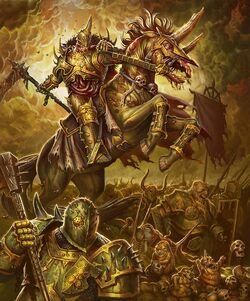
An army of Nurglish warriors in combat.
Thousands of years ago, before the coming of Chaos, the god-like Old Ones governed the world and shaped it with powerful sorcery. This epoch is now forgotten, except in the most ancient and obscure myths of the High Elves, or in faded inscriptions within the mysterious temple-cities of Lustria. The Old Ones dwelt in these temple-cities, guarded by their Lizardmen creations and served by amphibious minions -- the Slann -- who shared their potent magical abilities. They created other servitor races, including the ancestors of Elves, Dwarfs, and Men, though these races have no knowledge of this truth.[4d]
This world was but one outpost of the Old Ones' vast empire across the cosmos, and they travelled to other worlds via stellar portals constructed at the northern and southern poles. Beyond these gates existed a chaotic ether of pure magical energy inhabited by malevolent things, not quite real and not quite unreal, formed of the energy unleashed into the Aethyr created by extreme emotions and base concepts -- wrath, lust, flux, and decay. These entities greatly desired to enter the realm of mortals and feast on the fears and desires of the fragile creatures that dwelt there. For millennia, the Old Ones kept this peril at bay with runic wards, but one day their defences shattered for unknown reasons, the gateways collapsed, and the raw energies of pure Chaos poured into reality.[4d]
The explosion spat gobbets of condensed, solid Chaos matter across the globe, and these meteorites mutated life wherever they landed. A huge chunk of this so-called "warpstone" was hurled into orbit to join the world's original, natural moon as the new satellite of Morrslieb. The nascent race of Mankind was corrupted, many twisting into vile Beastmen. The tribes of the North were warped in mind and body and offered fealty to the Chaos Gods in return for survival. The tribes of the south in the Old World fled to the forests and caves for safety. No histories of this time exist among Men, for all Humanity was still but a race of savage brutes.[4d]
The Old Ones vanished forever, leaving the remnants of the Slann to organise the defence of their devastated cities against the Daemonic hordes that invaded from the shattered gate. Xahutec was first to fall, swamped by the combined might of all four Ruinous Powers. However, the temple-city of Chaqua proved harder to destroy. No Daemon could penetrate the magical shield raised by the Slann of that city. Neither Khorne's strength, Slaanesh's guile, nor even Tzeentch's magics could break the barrier. In the end, it was only Nurgle's pestilential concoctions that brought its defences down.[4d]
Bowelsteep, the Red Ague, and a thousand other poxes and pestilences infected the Lizardmen defenders of Chaqua. They gradually sickened, their scales flaking from their bodies and their limbs wasting away until they were nothing but shivering carcasses of hide and bone. The magic of the Slann could not save them from the Plague Lord's diseases, and they too withered, croaking feebly as their flesh erupted with foul, cankerous lesions.[4d]
The Lord of Decay, as a way of thanking them for humiliating his brother gods and allowing him to claim the glory, bestowed upon them Nurgle's Rot, the most devastating and beloved of all his many handiworks. The fall of Chaqua was Nurgle's greatest victory in the first Chaos Wars and a taste of the power he would hold over mortals for millennia to come.[4d]
Meanwhile, in Ulthuan, the High Elves' mastery of magic helped them weather the storm, and in the Old World, the Dwarfs emerged unscathed from their mountains to battle the armies of Chaos. For decades these races fought at the edge of defeat until the High Elves performed a powerful ritual that sucked the howling magical winds of Chaos from the world. Without this power to sustain them, the Daemonic legions weakened and were hurled back to their insane realm. However, the golden epoch of the Old Ones was gone forever, replaced by an era of conflict and strife where the Chaos Gods plotted eternally to conquer the mortal lands.[4d]
When Nurgle first entered this new world, he found it ripe with fecundity. He was irresistibly drawn to the rhythmic beat of life, but could not resist manipulating and twisting nature for his own amusement. In the ordered cosmos of the Old Ones, disease and suffering were virtually unknown. Slann, Lizardmen, Elves, and Dwarfs -- their first creations -- are even today long-lived beings, little affected by disease and the ravages of old age. [4d]
However, Mankind was created at the cusp of the disaster which nearly destroyed the world and was not only imperfectly formed but subject to the full corrupting power of Chaos. Men were sorely affected not just by mutation but also by Nurgle's meddling with the natural order of things. Legends among the Chaos-worshipping Human tribes of the North tell how a million new forms of life blossomed at the Plague Lord's will -- all the viruses, pathogens, parasites, and venomous pests, both great and small, that bring misery and death to the mortal realm to this day.[4d]
Manifestation
"The Lord of Flies will eat your eyes,
When last your breath gives out.
And if you cry before you die,
He'll kill you with the gout!"
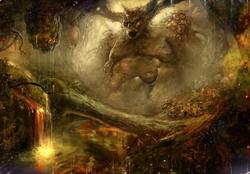
The Chaos God Nurgle, lord of disease, despair and decay, within his putrid garden in the Realm of Chaos.
Nurgle is usually depicted as an immensely obese humanoid whose scabrous flab is the greenish-brown hue of decomposing flesh. His paunch, swollen with corpse-gas, spills stinking organs, and a legion of Daemonic mites -- Nurglings -- play among his entrails and suckle the pus-riddled discharge streaming from his sores. Fat flies hum around his antlered head. His blubbery, pustulated face wears an amiable smile of contentment.[4a]
Nurgle is also often depicted as a grotesquely fat humanoid, his sickly green skin festering with wounds, sores, and oozing pus. His bloated face leers and is often pulled back in an ironic smile, with an immensely long tongue ending in a smaller, twisted face. Two grand horns, yellowed, chipped, and encrusted in blood and vile substances sprout from his head. Nurgle adores his own visage, and as a result many of his Daemons often appear as smaller versions of him. Sitting on his throne, he pets and preens his minions, offering cooing words of adoration, but simultaneously crushing untold numbers beneath his bulk or with a casual swat of his oozing hand. His domain is vile beyond compare; imagine all the cesspools and charnel pits of the world combined into one seething mass. Those that view his hideous manse never again feel that they can be clean and see the mortal world for the pit of filth that it really is.[2e]
Nurgle's sacred number is seven, and the endless varieties of his mark incorporate a triangle of three circles representing the unending cycle of birth, suffering, and death. Nurgle is often referred to as a "he," with the masculine gender, though in fact, like all the entities composed of magical energy called the Chaos Gods, it in fact has no true gender.[4a]
Mythology of the Old World represents the Lord of Decay dwelling within a massive, dilapidated fortress-mansion in his Land of the Plaguelord in the Realm of Chaos, the infernal abode of the Ruinous Powers that exists beyond mortal concepts of time and physical matter. Within the crumbling walls of his workshop, beneath a mildewed ceiling sagging with damp, Nurgle toils before a steaming cauldron.[4a]
He beams with excitement as he mixes strains of pox and fever to create a poisonous stew of pestilence, for although every known disease infects his monstrous body, he is obsessed with creating new ailments. When he is satisfied by his efforts, he pours the concoction into the grate below, and chortles with happiness as he watches the nauseating plagues rain down upon the mortal world.[4a]
Nurgle is most generous in bequeathing his diseases to mortals, all of whom he regards with great affection, and he ensures that rich and poor alike share the rotten fruits of his labour. He is not a god of destruction -- in truth, the Plague Lord deeply cherishes all life. The spluttering of the newborn babe is as dear to him as the slithering of the maggot hatched in its gut. It is simply unfortunate that the most prevalent forms of life in the world -- the unseen worms, viruses, and bacteria -- are so inimical to all the others.[4a]
The one thing that binds all mortals, however, from the crude Human tribesmen of the Northern Wastes to the refined aristocrats of Altdorf's Imperial court, is that every one of them is subject to illness, gradual atrophy, and eventual death. They are bound to a world where nothing is permanent -- in future aeons, even the great Fauschlag, upon which Middenheim is built, will be worn away to dust. Most civilised folk hide from this simple truth by finding solace among immortal deities in stone temples that emphasise the illusion of eternal permanence. [4a]
The Plague Lord's worshippers, meanwhile, can be said to be the most joyous of mortals, but theirs is the insane glee of those who have already resigned themselves to damnation. They fully embrace their eventual decay and mortality and offer their souls to the Chaos God who embodies this mouldering state: Nurgle, the Lord of Decay.[4a]
Temperament
Nurgle is viewed as a "loving" god by his worshippers, and he takes great interest in their activities and plots. Particularly favoured followers receive the worst of his diseases and plagues and often become twisted monstrosities from terrible mutations. Nurgle spreads disease through subterfuge, whispering to his followers to mingle with the masses whenever possible. He is not averse to warfare and sees it as an excellent vehicle for allowing new plagues to fester in the wake of terrible wounds, ruined crops, and tainted water. It is said he whispers in the ears of the wounded on the battlefield, offering them an eternal, if rotted, life if they give in to his call.[2e]
Nurgle takes great pride in blessing healers and physicians, helping them to understand the true beauty of plague. He loves beauty and beautiful things, being attracted to such things first. He never wants to destroy, but rather to improve, to instruct, and to reveal the hidden wonders of disease. Of course, his nature tends to rot and decay those objects he fancies, but such effects are acceptable since Nurgle sees glistening decay as an enhancement to any object's natural beauty.[2e]
Philosophy and Methods
"I had a lucky escape. Some handgunners came with a Priest of Sigmar to board up me front door. And when I asked them what they were up to, they said it was under the plague laws. Well, I had a bit of the sniffles, and me wife, Hilde, had been poorly for weeks. So the priest says 'Hans Braun, by Imperial decree, you are hereby ordered to stay...’ Well, 'No!' says I. 'I'm Felix Braun. Hans Braun lives next door.' Of course, I never saw my unfortunate neighbour again."
- —Hans Braun, Reiklander peasant[4k]
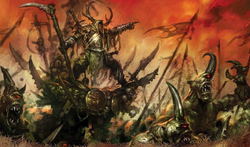
An army of Nurgle spreads the unholy "gifts" of the Plague Lord.
Nurgle is the vile Chaos God of disease, decay, and entropy. As the Lord of Pestilence, he is the inventor of torments, the father of plagues, and the giver of corruption. He delights in spreading his lovingtouch of pestilence to mortals, spawning new plagues to give as gifts to the living. Despite his sickly countenance, Nurgle is strangely robust and full of unholy life. His followers seem to grow in strength, even though their bodies are wracked with sores, flesh-eating viruses, and filled with phlegm and blackened blood. He's noted for his twisted sense of humour and joviality, and shows an unhealthy love and appreciation for his mortal followers.[2e]
Nurgle strives to spread his presence throughout the Known World via plague and filth, and he desires nothing more than to see the Old World turned into a stinking pit of death, decay, and plague. Nurgle sees beauty in all things foul, revelling in the glistening sheen of a throbbing pustule and exulting in the waxy pallor of a mortal succumbing to one of his many contagions. Nurgle sees it as his duty to awaken the secret beauty in all things, unlocking the hidden wonders of decay. To the Fly Lord, beauty is something that can be enhanced by his caress, and so he seeks to beautify the world with his blessed touch.[2e]
Nurgle is the god of pestilence and disease, and so is it not surprising that all the sickness which inflicts the mortal world is generally from him. Plague and pestilence have swept across the Old World in wave after wave since before the time of Sigmar. Whether an outbreak targets people, livestock, crops, or all three, it brings death and suffering and can have long-reaching impact upon the welfare and prosperity of the peoples of the continent.[4i]
In the Empire, there are countless rumours of diseases crossing the Southern Sea on ships from Araby, arriving upon the northern shores in crippled plagueships, brought across the mountains by trade caravans, carried through the forests by Beastmen, or erupting as if from out of nowhere within the great cities.[4i]
The most famous and most severe outbreak was known as the Black Plague, which occurred several centuries ago. The plague destroyed entire towns and villages. So many people died that they were left unburied, or heaped in mass graves of plague victims. It took hundreds of years for the population of the Old World to recover, but the ramifications can be felt even today. The very words "Black Plague" can bring fear. The skeletons of some ruined villages long reclaimed by the forests surely still remain undiscovered, where entire populations were stricken by the plague.[4i]
Nowadays, cities are often the places where plague is feared the most. The filth and the crowds mysteriously seem to help diseases spread. Outbreaks occur sporadically, potentially decimating the population of a single city before disappearing.[4i]
In 2300 IC, there were reports that the entire city of Mousillon in Bretonnia was virtually wiped out by an outbreak of the Red Pox. Some physicians fear it can only be a matter of time before something similar strikes an Imperial city. Because of the potential for utter catastrophe from even a single outbreak, much work has been done by some of the Empire's finest minds, in an effort to prepare for the worst.[4i]
The cult of Verena, the goddess of knowledge and justice, and the cult of Shallya, the goddess of mercy and healing, have worked closely to this purpose, attempting to discover new cures and techniques. This is certainly an exciting time in Imperial history for progress in such research. All sorts of new theories have been put forward on the nature of diseases, their cause, and how they are spread.[4i]
The popular miasmatic theory proposes that many ailments are spread by bad smells. The Cult of Shallya tends to personify the source of all disease, naming the Dark God Nurgle as the force behind all contagion. Others disagree and say whatever Nurgle is, he only manipulates diseases that are already in existence. The debate on nature versus Nurgle rages on.[4i]
Other theories say that disease is simply a weakness of the mind or spirit and that a positive attitude and a proper sense of morality will keep one safe. Others claim that diseases are a result of the alignment of the heavenly bodies and that astrologers should soon be able to predict any outbreak and perhaps even find cures. Some say all diseases are spread by ginger cats.[4i]
What is generally accepted amongst the educated of the Empire is that diseases might be passed from person to person by contact. This means that those suspected of being infected, or even of being in recent contact with a diseased person, might be shunned. They could be refused entry into towns, or perhaps beaten or chased off. In some extreme cases, a diseased person and their family might even be boarded up in their home and left to die by their neighbours, either of the disease or of starvation.[4i]
In truth, Nurgle spreads disease through subterfuge, whispering to his followers to mingle with the masses whenever possible. He is not, however, averse to warfare and sees it as an excellent vehicle for allowing new plagues to fester in the wake of terrible wounds, ruined crops, and tainted water. It is said he whispers in the ears of the mortally wounded on the battlefield, offering them an eternal, if diseased and rotted, life if they give in to his call. He is viewed as a "loving" god by his worshippers, and he takes great interest in their activities and plots. Particularly favoured followers receive the worst of his diseases and plagues and often become twisted monstrosities from terrible mutations.[2e]
Nurgle takes great pride in blessing healers and physicians, helping them to understand the true beauty of plague and disease. He loves beauty and beautiful things, being attracted to such things first. He never wants to destroy, but rather to improve, to instruct, and to reveal the hidden wonders of disease and the great truths of decay. Of course, his nature tends to rot and corrupt those objects he fancies, but such effects are acceptable since Nurgle sees glistening decay as an enhancement to the natural beauty of any object or person.[2e]
Rivals
"Every time we pull out a body from a house that's been ravaged by the plague, we sense his presence. Whenever I find some blighter face down in the street covered in sores and we have to either haul him to the physician or the grave, I know that he's there. Each time I hear rumours of the Green Pox making its way towards the city, I know that the Lord of Pestilence is laughing at us."
- —Dieter of Middenheim, Street Sweeper[2d]
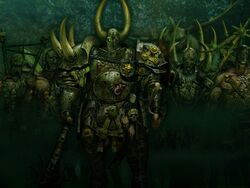
A tribe of Nurglish warriors ready to further the Lord of Decay's cause.
In the legends of the Human Chaos tribes of the North, Nurgle affects a garrulous air of overfriendliness towards his brother gods, but his benign nature masks his real opinions. Khorne's reckless urge to destroy upsets him, for Nurgle has a patient and nurturing heart. Slaanesh's indolent nature disgusts the Plague Lord, who is always feverishly busy in his workshop.[4b]
However, Nurgle reserves most of his ire towards Tzeentch, who represents constant, fluid motion and instant change, whereas Nurgle delights in gradual maturity and the musty scent of stagnation and despair. Tzeentch returns the Plague Lord's disdain in full.[4b]
In the Realm of Chaos, when Nurgle's chaotic garden in the Land of the Plaguelord intrudes into Tzeentch's bordering domain, the minions of the Changer of Ways sear the corrupted vegetation with magical fire. Plaguebearers shuffle forth to protect the garden, and what begins as a dispute over a few stray tendrils of scabrous ivy, escalates into a full-blown Daemonic conflict that can last for centuries as measured by mortals.[4b]
The myths of the northern tribes tell of an eternal competition, the Great Game, played by the four Ruinous Powers -- Tzeentch, Khorne, Slaanesh, and Nurgle -- each brother trying to dominate his siblings. But Nurgle, obsessed with his ceaseless foetid experiments, seems to care little about the Great Game, and when he meets to parley with his brothers at the infernal Court of Covenant, he is always portrayed as a talkative buffoon.[4b]
Yet his enthusiastic humour subtly undermines the plotting and politicking of the other Chaos Gods -- it drives Khorne to an unthinking fury, disturbs Tzeentch's insidious train of thought, and distracts Slaanesh from his scheming. Meanwhile, Nurgle's own intrigues spread slowly like a contagious fever.[4b]
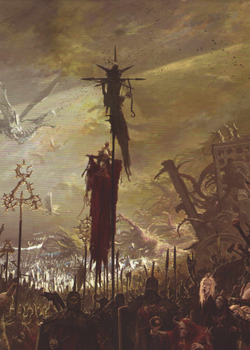
The skies darken with clouds of flies, heralding the coming of the forces of the Plague Lord.
The Great Game's chessboard encompasses both reality and unreality. In the Realm of Chaos, Daemonic legions loyal to each Ruinous Power clash in unending battle at the borders of their territories. Yet these wars come to naught, as each god is well defended within their home domain. Though the walls of Nurgle's mansion look fit to collapse, they have never been breached; a vast garden, always vibrant in autumnal splendour, surrounds his fortress. The swampy ground sucks trespassers to their doom, and the overgrown plants form dense thickets of flesh-tearing thorns and venomous leaves. The air resonates with the drone of flies and is heavy with choking spores from slimy, misshaped fungi. Centipedes, slugs, and a thousand other poisonous pests infest the decomposing mulch. Nurgle's leprous Daemons stalk the garden, quick to necrotise the flesh of intruders with their plagueswords.[4b]
However, it is within the mortal world that the vital moves of the Great Game are truly played. In the Chaos Wastes, savage Men worship Grandfather Nurgle as a deliverer from the very diseases he inflicts upon them, for he grants loyal followers freedom from the suffering of their afflictions. Some tribes and warbands of Chaos Warriors dedicate themselves to the Lord of Decay, nurture and spread his plagues, and war against those who refuse to exalt him above other deities.[4b]
The Ruinous Powers play out their eternal game among the northern wastelands, soaking it crimson with carnage. Although Nurgle's Chaos Warriors and Chaos Champions are not as bloodthirsty as those of Khorne, or as cunning or agile as those of Tzeentch and Slaanesh, they are highly resilient fighters -- it is difficult to kill someone whose diseased flesh completely shrugs off pain.[4b]
And yet, the battles in the Chaos Wastes are just a prelude to the real focus of the Great Game. The Ruinous Powers expend most of their efforts trying to destroy the civilised realms. The Empire is their greatest prize, for it is the most populous, wealthiest, and most powerful realm of the Old World. The Dark Gods vie for control over this land, implanting Chaos Cults to weaken the Empire from within and raiding its borders with their warbands.[4b]
It is in this arena that Nurgle truly excels. Khorne's appeal is confined to those maddened by bloodlust, Tzeentch draws those addicted to magic and arcane knowledge or who thrive on cunning and lies for advancement, and Slaanesh attracts degenerates and hedonists. In contrast, all mortals eventually feel Nurgle's presence. The Lord of Decay is a patient player, for it takes time to brew his plagues, but his influence gradually spreads throughout the world.[4b]
Nurgle's cults rot the Empire's core, weakening the strength of the Emperor's armies and the morale of his civilian subjects by disseminating disease. A single cough can lay low an Imperial general where feats of arms have failed. A sneeze can decimate an entire town.[4b]
Where subtle measures fail, cultists can rip apart the veil between reality and the Realm of Chaos, summoning Nurgle's Daemons to lay waste with their contagions. As pestilence grips the world, Nurgle's power eclipses that of his brother gods. However, while the Ruinous Powers compete against each other, they can never defeat the steadfast Empire individually.[4b]
More than two hundred years ago, the Ruinous Powers buried their differences and almost succeeded in overrunning the Old World with their armies during the Great War Against Chaos. Only the courage of the emperor remembered as Magnus the Pious and the blood of the brave Men and Dwarfs who fought under him thwarted the Dark Gods' ambitions.[4b]
Now the Empire enjoys a new golden age, but the Ruinous Powers have decided to set aside their game again, and have chosen a new, single champion of Chaos Undivided to represent them all -- Archaon, the Lord of the End Times. Having united the tribes of the Chaos Wastes, Archaon's gaze now turns to the lands of the south, and his dreams are filled with blood and fire.[4b]
Symbols
Nurgle's primary mark is three spheres stacked in a triangle, which scholars of the Old World ascribe as being akin to pustules, buboes, or other symptoms of disease. The chosen of Nurgle often find this symbol growing on their festering skin as the Mark of Nurgle. Other symbols include flies, tentacles, open maws, and disgusting chalices dripping with infectious effluvient.[2e]
The Plague Lord's sacred colours are sickly greens, yellows, and browns. Followers don filthy, vomit-encrusted rags and tattered clothing in his colours, adorned with rotting limbs and bits of diseased flesh and skulls. They often carry soiled banners bearing the Mark of Nurgle before them as they wander the Old World, looking to spread his blessings.[2e]
Nurgle's sacred animals are the fly, the maggot, and the carrion crow, though all creatures that feast on the decayed dead or spread virulent plague are favoured in his eyes. Animals that are on their last legs due to plague are often sacrificed to Nurgle and left to rot in the wells or food stores of the healthy.[2e]
Tenets
Followers of Nurgle have few real tenets of their pestilential faith, other than to spread disease and despair throughout the world. His teachings are as follows:
- Seek out new corruptions as they are blessings and signs of Grandfather Nurgle's favour.[2e]
- Instruct the world in the bounty of Nurgle's love. Be not stingy with his gifts and share them wherever you can.[2e]
- Search for beauty in all things, and when found, celebrate it. And when beauty is found, perfect it by sharing the blessings of Nurgle.[2e]
- Pity those who follow the Lord of Change, for they know not the true meaning of exquisiteness. Never fail to bestow onto them the greatest of gifts, sharing with them the essence of your afflictions.[2e]
Cults of Nurgle
"It's in your holy books or even written in the stars. They are inscribed on your very flesh. Each gangrenous wound, each itching boil, each suppurated abscess illuminates the majesty of the true master of the world."
- —Confessions of the heretic Adolphus Grimmer before the Templars of Sigmar[4e]
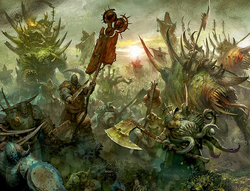
The mortal and Daemonic servants of Nurgle
It is not the incessant warring between Daemonic armies in the Realm of Chaos or even the epic clash of Chaos Champions among the barbarian tribes of the Chaos Wastes that truly enthuses Nurgle, but the conflict against the unconquered civilized realms of the mortal world. High Elves and Wood Elves perplex him, for they are long-lived and unblemished by age, and are blessed with a natural resistance against disease. Dwarfs infuriate him, for they are as resilient as stone. These races frustrate Nurgle's efforts to contaminate and corrupt them, and he thus deems them fit only for eradication.[4e]
Humans, however, rot so very easily, embracing Chaos corruption and temptation with so little effort. For this reason, of all the intelligent mortal races, Men intrigue Nurgle the most. The pitiful cries of afflicted men, women, and children fill him with love for this frail race -- they are indeed worthy hosts for his contagions.[4e]
The Plague Lord bestows his diseases to ruler and pauper alike, for all are equal in his eyes, and his plagues reduce all people to the same state -- they become so desperate in their pain and despair that they would cast away their worldly treasures and betray their loved ones for the slightest reprieve from their suffering.[4e]
Of all the Human kingdoms, one of the most fascinating to Nurgle is the Empire of Man. Its cities teem with life ripe for infection. It is to Nurgle's eternal regret that the short-sighted souls of that realm have proscribed his worship. He rains down disease upon the folk of the Empire and watches them struggle to survive like rats on a sinking ship. Their choice is simple -- perish in excruciating agony or invoke the name of the Lord of Decay. Unfortunately, most people are blinkered by the lies of their priests, but a few enlightened souls call out his name, and he is quick to answer.[4e]
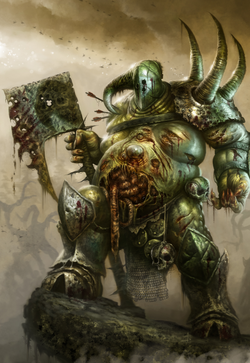
A Chaos Champion of Nurgle
Those who embrace Nurgle embrace their own doom, for they are disfigured by disease and mutation and their own features cause dread among others, but in return they lose the fear of their inevitable demise. If those who embrace Nurgle prove their devotion, he grants them his sacred Mark to wear in their corrupted flesh and frees them from all the physical tribulations of mortal life in return for their immortal souls.[4e]
To win this prize, Nurgle's faithful must please their god by infecting others with the diseases and afflictions they carry, spreading the Plague Lord's "gifts." For this reason, they bear their infirmities and corruptions with great stoicism, in the belief that eventually, Grandfather Nurgle will deliver them from all suffering.[4e]
Followers of Nurgle often band together, and there are many Chaos Cults of Nurgle within the Empire, meeting secretly in filthy places to praise their foul god and plot how to spread his pestilences. Some are well-established, recruiting new members from among the sick and desperate -- those who yearn to cling to life by any means necessary. Others flourish only briefly before being eradicated by the diseases they foster -- a sign to some cultists that they have failed Nurgle, but to others that they have pleased him, and he has taken their souls to his garden in the Realm of Chaos where they can serve forever as his Daemonic minions of decay.[4e]
Some cults of Nurgle mirror Human society's natural social stratification, with the leadership reserved for those of noble birth. Some cults' hierarchies are based instead on the extent of affliction siuffered by their members, with the plagued poor lording it over less diseased high-born followers.[4e]
Some cults only recruit from among the Imperial aristocracy, others from only street scum. Many compete with each other, jealous for Nurgle's favour, and may even undermine the plans of rival cults of the Plague Lord. Nurgle's cults also operate in direct confrontation with those of the other Chaos Gods, particularly those of Tzeentch, who Nurgle teaches his worshippers to despise.[4e]
However much this petty infighting amuses Nurgle, his main obsession is to corrupt those loyal to the Empire and the [Old World Pantheon|Imperial gods]]. Should the Empire fall to anarchy, other realms will soon follow, and the Old World will be ripe for invasion by the Chaos hordes mustering in the northern Chaos Wastes.[4e]
To this end, the cults of Nurgle contaminate from within. When woodworm burrows into the oak beams that support the walls and roof of a proud mansion, the entire edifice will eventually collapse. Likewise, the cultists of the Plague Lord worm their way into Imperial society, spreading disease and thwarting those who try to stem infection and sickness.[4e]
Cultists who have influence in Imperial society, the bureaucrats and advisors to the nobility, use subtle means to spread Nurgle's gifts, such as ensuring that basic civic sanitary amenities -- drains, sewers, and midden heaps -- are neglected, causing rampant sickness to be more likely to spread amongst the urban populations of the Empire.[4e]
Other cultists secretly infect local water supplies or food stores, or simply wander among the crowded city streets, covertly passing their illnesses to everyone they meet. The armies and garrisons of the Empire are favourite targets, for disease can cripple a fighting force long before a battle is fought.[4e]
Favourite recruiting grounds for cultists of Nurgle in the Empire include hospices, leper colonies, and filthy urban slums -- anywhere that the already-diseased congregate. Influential cultists may even be able to sidle to the bed of a sick aristocrat and whisper promises of deliverance to their fevered patron behind the backs of his physicians. Of course, all cultists must act surreptitiously, for the agents of the Emperor, of Sigmar, and the other gods of Mankind are always on the alert to eliminate the followers of Chaos.[4e]
A major obstacle to the efforts of a cultist of Nurgle is the repulsiveness of his ailments and diseases, which are often difficult to hide, and many of the Dark God's most favoured servants also develop hideous mutations as a further reward for their loyalty.[4e]
Although such cultists are proud of their bodily deformities, if they cannot hide them then they cannot operate within Imperial society, for their mutations will draw the attention of the witch hunters or a lynch mob of terrified peasants or townsfolk. Thus, many senior cultists of Nurgle are forced to hide themselves away, and use newly initiated members less afflicted by decay and Chaos corruption to perform tasks among the public.[4e]
Where subtle means of corruption are ineffective, some cults prefer direct action. Although Nurgle is not as powerful a sorcerer as Tzeentch (a source of great jealousy to the Plague Lord), he does possess great mastery over the Winds of Magic and imparts his abilities to his most deserving followers. Those who dabble in the sorcery of the Lord of Decay can inflict disease and pestilence by magical means, and do so to blight and cripple their enemies, as well as to reward their followers with fresh ailments.[4f]
Some cult leaders delve into rare grimoires, possession of which earns the death penalty in the Empire, and learn foul rituals to raise magical squalls that can spread deadly plagues far and wide. Many folk blame such warlocks and witches when crops fail, famine strikes the land, or when epidemics ravage entire regions, leaving rotting corpses in their wake.[4f]
Nurglite cultists who have mastered the arcane rituals of their god might also try to invoke Nurgle's Daemonic minions from the Realm of Chaos. Daemon-summoning is a risky practise, for uncontrolled Daemons are wont to destroy their summoners. Ceremonies of summoning are long and complicated, and successful rituals are few and far between but devastating in the extreme.[4f]
It was a cult of Nurgle, the Order of the Septic Claw, which caused an infamous catastrophe in Altdorf way back in 924 IC. The pestilence known as the Crumbling Ague swept through the city, causing great loss of life, but the cult discovered that the priests of Shallya, the goddess of mercy and healing, were close to finding a cure.[4f]
In response, the cultists performed the necessary rites and caused an unending swarm of Nurglings to pour from the cauldron in the centre of their infernal circle. The tiny Daemons killed thousands of citizens and piled on top of the temple of Shallya, which collapsed under their weight, crushing the priests inside and destroying all hope of a remedy. The Nurgling infestation disappeared as quickly as it had come. Nothing is known of the fate of the cultists who summoned this putrid tide.[4f]
Were it not for the ministrations of the priesthood of Shallya, physicians, barber-surgeons, and other healers, the Empire would have fallen to Nurgle's plagues long ago. The followers of Nurgle despise these meddlers and hatch plots to disrupt their work or even to murder them. For almost every disease Nurgle concocts, somehow these mere mortals discover a cure.[4f]
In popular folklore of the Empire, the goddess of mercy, Shallya, is Nurgle's arch-enemy, thwarting his every move. The greatest coup a cult of Nurgle can achieve is to corrupt to the service of the Lord of Decay a doctor of medicine, folk-healer, or priest of Shallya, for through them the Plague Lord would be able to wreak great havoc.[4f]
Nurgle's bitterest enemies in the Empire are the witch hunters of Sigmar who stop at nothing to eradicate all Chaos worship. Almost incorruptible, their willingness to destroy the innocent to reach the guilty makes them dangerous foes. Most cults of Nurgle go to ground at the mere hint of an investigation by witch hunters, yet these diligent servants of Sigmar can often sniff out even the most cautious Chaos Cult, and will condemn its members to torture, a swift trial, and consignment to a blazing pyre.[4f]
The followers of Nurgle have few allies, for none but the most insane would want to expose themselves willingly to their contagions. However, among the highest echelons of Nurgle's cults, there are a few who have dealings with the secretive and subterranean ratmen known as Skaven. An urban myth to most citizens of the Empire (the wily Skaven cultivate such ignorance among the Empire folk), the ratmen reveal their existence to few Humans. The minor Chaos God worshipped by the Skaven, the mysterious Horned Rat, shares many of Nurgle's ideals concerning disease and decay, and would see the entire Old World laid low by pestilence.[4f]
Sometimes the Skaven make an alliance with the servants of the Plague Lord, manipulating his followers to further their own schemes. An unwary cult leader who allies with these creatures is likely to meet a grisly death when he is no longer of any use to them. Usually, however, Skaven avoid contact with the cults of Nurgle, knowing that they may be seen as rivals, not allies, and only interfere when the cults' ambitions obstruct their own.[4f]
As to how Nurgle regards the children of the Horned Rat, nobody knows, as there are no tales or legends where the two come into contact. No doubt the Skaven excite within him a desire to witness the symptoms that his newest concoctions have on their verminous physiology.[4f]
Cavalcades of Nurgle
The diseased are unwelcome wherever they go in the Old World. A sharp-eyed gateguard can refuse them entry into town, and villagers close their doors upon strangers who look ill, for good reason. Groups of diseased folk might be expelled from a city, before an outbreak can really take hold, for the good of all the citizens. And so many disease victims are left to die out in the wilds.[2j]
But some survive. Shunned by society, they roam, begging and stealing and scratching what existence they can, resenting their rejection while coming to terms with their afflictions. These wandering folk meet with others in similar straits and soon a community is born: a caravan of wagons moving from town to town, feared by normal folk, doing as best they can, even glorying in their predicament.[2j]
This is a prime breeding ground for the followers of Nurgle. The people find succour only in his devotion and meaning only in his teachings, for all the other gods have forsaken them. The travellers are often joined by Daemons of Nurgle in their cavalcades, openly flouting the laws of the Empire. Few are brave enough to intervene.[2j]
Even some witch hunters will leave these folk to their inexorable decline unless they can summon the manpower and resources to purge them with sword and fire. Unfortunately, these victims find vitality in their mortality and Nurgle's sickly sweet blessings give them the will to continue.[2j]
But there is an even stranger thing about Nurgle's cavalcades. It is said that when Morrslieb is high in the night time sky, when the townsfolk see the procession as if a carnival was approaching, instead of seeing the pathetic sick approaching in their raggedy wagons pulled by emaciated beasts, they see a bright and gay carnival of entertainers and showmen. They see dancers and musicians skipping along, filled with joy. The town gates are opened, and the cavalcade rides inside...[2j]
Despite recent medical progress in universities and surgeries across the Empire, it seems the physicians and doktors of the Old World are fighting a losing battle; disease can strike at any time, killing thousands, decimating cities, creating despair and upheaval, and weakening the Empire.[2j]
When an outbreak does occur, the Cult of Shallya, the goddess of mercy and healing, is quick to react. Her priests fearlessly go into disease-affected areas to minister to the afflicted and to learn what they can about the disease, hoping to find the basis of a cure in the midst of the infection. They may be joined by solemn followers of Morr, the god of the dead, who have no particular interest in the disease itself, but a need to make sure the dead are properly put to rest.[2j]
Priests working in areas where an outbreak has been reported will often wear heavy robes, gloves, and large hats with wide brims to protect themselves from the disease. They might wear thick leather masks fitted with special glass goggles. The mask has a pronounced snout or beak which often contains onions or herbs to combat the disease and protect the wearer. Needless to say this would be a very imposing sight, and this image is associated with disease and death across the Empire.[2j]
Rather than seen as a sign of salvation or hope, in some unfortunate cases, the sight of a Shallyan priest dressed in such garb has been seen as a harbinger of greater misfortune and death -- for people know things are truly dire.[2j]
The Cult of Shallya creates and supports many hospices and sanatoriums across the Old World. There they care for sufferers until they die or recover, and the cult attempts to learn from them. There is a great demand for such a service, especially in the cities.[2j]
The Cult of Sigmar can use its political authority across the Empire to ensure that an outbreak of disease is contained as much as possible. They can prevent suspected infected citizens from travelling, or detain them until a physician or Shallyan can properly inspect them. At times this has lead to the containment of entire villages. If even one villager is suspected of having one of the more feared diseases, like the Plague or Red Pox, the entire village may be essentially cut off.[2j]
Under such dire circumstances, Imperial troops are called upon to make sure no one leaves the village, and if anyone wishes to enter it, they are not allowed out again. Eventually this siege against disease will be lifted, and sometimes there are even survivors. Shallyans often enter such a quarantined village, trusting in the goddess to protect them as they bring succour to the suffering villagers.[2j]
Mark of Nurgle
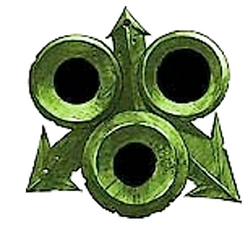
A variant Mark of Nurgle
The Mark of Nurgle is reserved for the Lord of Decay's most loyal servants. They develop a tolerance to pain, despite their festering flesh, allowing them to enjoy the slow degeneration without distraction. They also become inured to battle wounds, making it difficult to slay them -- they literally have to be chopped to pieces before they die.[4g]
The mark also provides complete immunity to the effects of any disease, and allows the bearers to easily spread any of the Plague Lord's pestilential "gifts" at a whim.[4g] [4l]
The Mark of Nurgle exhibits itself somewhere on the body as three circular lesions forming a triangle, which some interpret as being the image of a carrion fly, while others hold that it represents the cycle of birth, decay and death. These lesions sometimes weep poisonous pus or are infested with wriggling maggots.[4g]
The mark may also cause difficulties for the servant of Nurgle who bears it. For example, it may smell particularly disgusting and need to be hidden with perfume. It may be a conspicuous and unsightly boil or rash which may bring misfortune when the Nurglite seeks to interact with others. It could also be recognisable to rivals who serve other Chaos Gods.[4g] [4l]
Gifts of Nurgle
Generous Nurgle is swift to reward his loyal followers with his dubious gifts of Chaos.
Disfiguring Diseases
The sane shrink from contagion in all its forms, but the followers of the Plague Lord are far from sane. They delight in the malignant cysts and carbuncles that Nurgle grants them. The stench of ripe sores is the finest bouquet to them, and the rasping coughs of the sick, sweet music.
Although Men are highly susceptible to disease, High Elves, Wood Elves, Dark Elves and Dwarfs are less so. Dwarfs can shrug off most ailments, whereas Elves can remain youthful and healthy throughout their long lives. It is for this reason that Grandfather Nurgle so hates those races and seeks their eradication.
Mutation
Like all the Ruinous Powers, Nurgle is ultimately a being of entropy, and can warp physical flesh at will.[4g]
Human flesh is as pliable as soft clay before the Dark Gods' power, and their minds and souls are easily corrupted, for they were a new mortal race when the Old Ones fell. The seed of Chaos was planted in the soul of every man, woman, and child, and carried to their descendants. Each Human has a choice: to struggle against the Chaos within them, or to give in to its lure and bow before the awesome might of the Ruinous Powers.[4g]
Many people have this choice made for them -- they are born among the Chaos-worshipping tribes of the northern Chaos Wastes, emerge from the womb with horrific mutations, or develop such aberrations in later life -- for the seed of Chaos can bloom at any time. Such unfortunates born in the Empire face death unless they somehow escape the witch hunter's flames. Some Humans willingly seek mutation as a sign of favour from the Chaos Gods, though they often succumb to their rebellious flesh, and devolve into a mindless mass of tentacles called a Chaos Spawn.[4g]
In contrast, High Elves, Wood Elves, and Dwarfs defy the Ruinous Powers physically and spiritually. Their bodies, created before the Coming of Chaos, are incorruptible. They protected themselves when Chaos flooded into the world -- the Elves with magic and the Dwarfs by hiding under their mountains, and so these races never develop Chaos mutations.[4g]
The Plague Lord favours mutations that reflect his aspect of decay and corruption. A mutant devoted to Nurgle may have the head of a dung-beetle or midden-fly, his tongue may transform into a writhing slug, or he might ooze necrotising slime from every pore. The more revolting the mutation, the more pleasing it is to the Great Corruptor.[4g]
Lore of Nurgle
Nurgle not only corrupts the flesh but sometimes empowers the mind. The Plague Lord and his most eminent Daemons can twist Dark Magic to their will, using it, for example, to rot skin and muscle, dissolve the earth into a cloying pit of slime, or conjure a choking odour.[4g]
Mortals can learn how to manifest such magical abilities as Chaos Sorcerers versed in the Lore of Nurgle by binding Daemons of the Plague Lord and forcing the spells from their lips -- a dangerous business -- or they can scour mildewed tomes of forbidden lore to master such vile magic.[4g]
Daemonhood
The ultimate gift of Nurgle is elevation to the ranks of his Daemons. Only the most powerful of his Chaos Champions can dream of becoming such a Daemon Prince, and only if they have piled the worm-riddled corpses of Nurgle's enemies high upon his decrepit altars.[4h]
However, any mortal can become a Plaguebearer, as long as they first endure the terrible curse of Nurgle's Rot. But it should always be remembered by all would-be servants of the Plague God that whether they are a Daemon Prince or a Plaguebearer or even a Great Unclean One, all Nurgle's Daemons are slaves to his divine will, bound to him for eternity. Chaos ultimately only ever offers slavery in return for immortality, not ultimate freedom as its adherents believe.[4h]
Land of the Plaguelord
"In the middle distance I saw a great fortress, half-hidden by the miasma of decay that infused its very structure. Rotten and mildewed were its timbers, and its sagging roof was thick with infestation of every conceivable kind. Poison poured down the walls of this most revolting of abodes, polluting everything about. Yet despite its state of decay, I sensed an inevitability about that unhallowed bastion. I knew beyond doubt that it had stood for years uncounting in that same ramshackle form, and would continue on until the very end of time. Before the fortress gates stretched a forest of death. Corpses, thick with unbridled decay, lay about it as far as my eyes could see. Here death was feeding off the dead. This was the Garden of Chaos. Vile creatures nested amongst the bones of the dead, there to gnaw at the fallen and fill the air with the sickly sound of merriment. Here dark trees had petrified, their shapes indescribable and their essence corrupt. The graves of the fallen had become a rich loam, sucked upon by the trees of that dark forest. Pierced by the tree roots, the dead had stirred once more and each branch bore a skull, mildewed and heavy with loathing. In that place I looked upon the fate of Mankind and wept for the future."
- —Liber Malefic[7a]
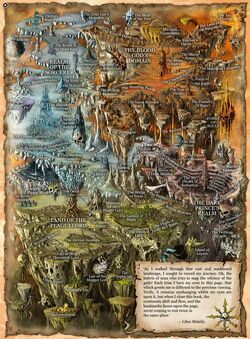
A map of the Realm of Chaos; note the positions and distances between the places on this map are only allegorical; distance and time have no meaning in the Aethyr.
Far from the light of any sun or star lies the infernal region known as the Realm of Chaos. This is not a material realm, but a place without physical or temporal boundaries, a vast, formless limbo that exists because of the dreams, and desires and emotions of intelligent mortals. This is the home of the Dark Gods of Chaos.[7a]
In the Realm of Chaos there are no physical laws akin to those that dominate the mortal world. Within its confines dreams become real, and reality is reborn as fevered hallucination. Gravity, shape, space and reason -- all are in flux, utterly mutable to the will of the Chaos Gods.[7a]
Few mortals are capable of perceiving the Realm of Chaos in its true splendour, for the living mind recoils from such otherworldly and impossible landscapes. For this reason, no two visions of the Realm of Chaos are alike, as the mortal mind attempts to hide the impossible with fragments stolen from memory. The Realm of Chaos is a place of dreams and nightmares, where cause need not follow effect and within its bounds anything is possible.[7a]
The Dark Gods of Chaos each have their own particular spheres of influence, their own Daemonic servants and their own sub-dimensional territories in the Realm of Chaos. All of these things are solely maintained by the willpower of the god in question -- without that drive, the kingdoms and Daemonic scions of the Chaos Gods would collapse once more into formless magical energy.[7a]
The Realm of Chaos is not merely the home of the Dark Gods. It is their battlefield, the arena for the Chaos Gods' eternal Great Game for power, influence and ultimate supremacy. The brothers in darkness are constantly at war with one another, vying for power amid the immaterial planes. Despite their myriad differences, the major Chaos Gods all share a common goal: total domination of all that is. Such absolute power cannot be shared, even amongst gods.[7a]
Daemonic armies clash across crystal plains, venomous forests, bone-choked swampland and rivers of churning gore, pursuing vast wars of attrition as the Chaos Gods claim and counter-claim territory and the magical life-blood that goes with it. In the Realm of Chaos, where magic is the very stuff of being, the breadth of a god's domain is not merely a symbol of power, it is indeed power itself. As the minions of one god seize advantage, that territory is moulded to the whims and hubris of its new master, sloughing off its old form to reveal a new countenance.[7a]
If Khorne's bloody minions overrun a portion of Nurgle's festering garden, the diseased foliage swiftly decays down to nothing, leaving only a barren and ruddy wasteland. Similarly, should Tzeentch manage to wrest that same territory from Khorne, iridescent crystalline structures will consume the blood-streaked plains.[7a]
On the border of Tzeentch's realm is the domain of Nurgle, the Land of the Plaguelord, sometimes called the "Garden of Nurgle." Although Nurgle is usually ranked behind Khorne and Tzeentch in power and influence among the major Chaos Gods, the truth is that his power is not necessarily weaker, just less stable than that of the other gods. When Nurgle unleashes his ghastly pestilences his power rises to a peak. Like a plague, his power grows and may reach epidemic proportions, temporarily overshadowing that of all the other gods put together.[7a]
It is for this reason that Nurgle commands a wary respect from all of his brother gods. Though Nurgle's Daemonic legions may not be as ferocious as those of Khorne, nor as numerous as those of Tzeentch, when Nurgle's power waxes even Daemons can fall prey to his repertoire of grisly afflictions.[7a]
Nurgle's great delight is in the cycle of existence, in life and death. At the heart of his mouldering mansion, he indulges this passion. Beneath mildewed, sagging, and worm-eaten beams, the great Chaos God labours for untold hours at an iron cauldron, a receptacle vast enough to contain all the oceans of the world. Nurgle works to create contagion and pestilence -- the simplest, yet most fecund, forms of life.[7a]
Such is the ghastly irony of Nurgle's existence: everything he does is with the goal of bringing more life into the mortal world, yet so many of his creations are inimical to other living beings that Nurgle is widely though of as a destroyer, not a creator. With every stir of Nurgle's maggot-ridden ladle, a dozen fresh diseases flourish. From time to time, Nurgle ceases his stirring and reaches down with a leathery hand to scoop a portion of the ghastly mixture into his cavernous mouth and taste the fruits of his labour.[7a]
Should the putrid soup meet with his approval, the god waddles to the corner of his workshop, where he holds Poxfulcrum, a Daemon that legend holds is blessed with the ability to heal all infections, but afflicted with an equal vulnerability to them all. Opening her corroded cage, Nurgle forces her to imbibe the putrid mixture, watching with ill-concealed excitement for the signs and symptoms of his latest creation. Though Poxfulcrum inevitably purges the disease from her body, the efficacy with which she does so allows the Plaguelord to evaluate the virulence of his new disease.[7a]
If Nurgle is pleased, he returns to his cauldron -- as he empties it into the grate below his workshop, the teeming liquid falls as rain upon the mortal world. If the concoction does not meet with Nurgle's approval, he begins to prepare his soup of pathogens anew.[7a]
As for Poxfulcrum, she whispers to mortals while the Plaguefather is busy at his cauldron, apprising them of cures for the ailments Nurgle unleashes upon the world. So has she entered the beliefs of a thousand mortal cultures under a thousand different names.[7a]
Some mortals believe her to be Nurgle's own Daemonic daughter, who cures only so that her father's new diseases can take hold in their place, while others see her as Nurgle's bitter divine captive, not a Daemon at all but a deity of healing and patron of the afflicted in her own right, much like the goddess Shallya in the Old World.[7a]
Nurgle's Garden
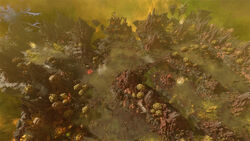
The Land of the Plaguelord in the Realm of Chaos as depicted in Total War: Warhammer III.
The creation of pestilence is not Nurgle's sole obsession. When not labouring at his iron cauldron in his great, decaying mansion, Nurgle cultivates the garden surrounding it with a tenderness and pride utterly at odds with his rank and loathsome appearance.[7a]
As with all worldly things within the Realm of Chaos, Nurgle's overgrown garden is of a scale large enough to befuddle the mortal mind. Within its bounds are the plants and trees drawn from a thousand worlds across a hundred different realities that know the touch of the Lord of Decay.[7a]
Bright sprays of red, blue, yellow and purple puncture the autumnal gloom: havens of splendid cheeriness in a dismal woodscape. Each strain of flora flourishes in its peculiar environment, though not all are immediately recognisable. Like any gardener, Nurgle cannot resist the recombining of his beloved strains. Almost everything in the Plaguelord's garden is some strange hybrid of plant, fungoid and Daemonic life. Perhaps as a result of this, the garden is alive with a kind of ghastly intelligence. It is not sentient, as such, but has enough carnivorous instinct and drive to attack intruders, its plague-smothered vines bestowing all manner of deathly poxes on those who foolishly come within reach.[7a]
As Nurgle's power in the Great Game grows, so too does the hideous splendour of his garden. At the zenith of the Plaguelord's power, the undergrowth becomes vital enough to burst over its boundaries and cast murky tendrils onto Tzeentch's neighbouring crystal labyrinth. Left unchecked, the decaying presence of Nurgle's plants crack and weather the arcane geodes from which the Changer of Ways' labyrinth is composed.[7a]
Such an assault, however unwitting, inevitably provokes Tzeentch's Daemonic minions to instinctively attack the intrusive foliage, using sorcerous fire to scour root, stem and branch from the shimmering labyrinth. This in turn rouses the paternal wrath of Grandfather Nurgle. Before long, the Daemonic legions of the Great Sorcerer and the Lord of Decay are at war once again. Such battles can last seconds or centuries, for they only cease when Nurgle's power -- and thus the unchecked growth of his garden -- recedes once more.[7a]
Notable Servants of Nurgle
Daemons
- Ku'gath Plaguefather - Ku'gath Plaguefather is among the most favoured of all Nurgle's Great Unclean Ones. Like all of the Plague Lord's Greater Daemons, Ku'gath has many names in many realms. In Naggaroth he is cursed as "Jharihn," in Lustria feared as "Xochitataliav," in Tilea hated as "Kisveraldo the Foul-Breathed," and in distant Grand Cathay reviled as "Zin-Fa the Ever-Pustulent." Whilst other Great Unclean Ones work to spread the plagues already extant, Ku'gath is fascinated by the breeding of new and virulent life. Ku'gath aims to one day breed a contagion that can infect the gods themselves. The Plaguefather prides himself upon his detachment. So absorbed is he in his search for the perfect plague, Ku'gath remains relatively untroubled by the shifting balance of power within the Realm of Chaos, yet this is not to say that the Plaguefather does not play his part in the Great Game. Ku'gath's experiments are nothing without practical results, and he is ever eager to test fresh creations on the battlefield. The Plaguefather rides upon a massive palanquin bedecked with alchemical paraphernalia: vials full of seething powder, flasks of indescribable liquid and hessian sacks stuffed to bursting with Nurglings. This great bulk is held aloft by a carpet of straining Nurglings, and Ku'gath is attended on by countless others, all bred from the Plaguefather's pox vats. Ku'gath's Nurglings are not merely servants — they are also ammunition, for in battle Ku'gath is wont to hurl them into the enemy ranks. The unwilling projectiles burst on impact, drenching the target with disease-ridden fluids. Ku'gath watches keenly as each Nurgling's pox takes effect. Should the plague achieve Ku'gath's expectation, he gurgles with a proud father’s delight. If the results do not meet with approval, Ku'gath immediately brews a refined version of the plague, dunks a fresh Nurgling, and lets fly once again.
- Epidemius[4n] - Epidemius, known also as the Maggot King, the Plagued Panjandrum and Reckoner of Mortality, is a Plaguebearer Daemon and a Herald of Nurgle who is Nurgle's chosen Tallyman, one of the seven Proctors of Pestilence and the cataloguer of all the Plaguelord's diseases. Epidemius' task is an unending one, and it generates a great deal of paperwork, so he rides a palanquin to share the burden -- and to more easily force a path through Nurgle's hordes. Two dozen Nurglings attend the Tallyman's every need, providing the parchment, operating the death's head abacus, excreting the ink for the quill pens and even defending Epidemius from harm should a foolish enemy venture too close. Epidemius brooks no idleness or distraction from his helpers who, unlike other Nurglings, remain deathly silent lest they disturb their master from his task and thus rouse his ire. Like Nurgle, Epidemius abhors anything that distracts from the serious matters of life and death. The only sounds that can be heard are the gooey shufflings as Nurglings heave the palanquin forwards, and the irritable scratching of the Tallyman's quill as he seeks to keep his records up to date. From his perch, Epidemius surveys the thrift and splendour of Nurgle's creations, making note of casualties and infection rates as well as secondary symptoms such as unusual colourations and odours. This information, properly collated and distilled, is of incredible value to Father Nurgle, but must be recorded with absolute precision and in a timely fashion to be of any use.
- Poxfulcrum [7a] - Poxfulcrum is the name of a female Daemon that an old legend claims Nurgle keeps caged in his workshop in his mansion in the Land of the Plaguelord in the Realm of Chaos because while she has the power to heal any infection, she is also vulnerable to them all. As such, the Lord of Decay tests the virulence of the contents of his iron cauldron of plagues upon her, forcing her to drink the noxious sludge, and then seeing how her body responds to the diseases it contains. Some versions of the legend even claim that Poxfulcrum is Nurgle's own daughter. While Poxfulcrum is cursed with a vulnerability to every disease, her body can also purge every infection afflicting it -- the ease with which she recovers from Nurgle's poisonous broth allows him to gauge its potency. Only when the symptoms of his new concoction please him does he unleash it upon the mortal world. In her suffering, Poxfulcrum weeps, and it is said that each tear can heal every ailment in the world. When Nurgle returns to his cauldron and is absorbed in his work, she is also said to whisper to mortals the secret cures for each of his diseases in revenge for her confinement. So has she entered the beliefs of a thousand cultures under a thousand names. Some mortals believe her to be Nurgle's daughter, who cures them only so that her father's new diseases can take hold in their world, while others see her as Nurgle's bitter divine foe, a captive deity of healing and patron to the afflicted.
- Alkhor - Alkhor, called "Alkhor the Defiler," the "Tide of Pestilence" and the "Sluglord," was a Daemon Prince of Nurgle who nearly succeeded in bringing his master into the mortal world to win the Great Game and who corrupted large parts of the forest of Athel Loren before he was defeated by the efforts of the Wood Elves and the forces of Khorne.
Mortals
- Festus the Leechlord[4m] - Festus the Leechlord was once a proud Imperial physician of the highest caliber, who rose to become one of Nurgle's most exalted mortal servants. Festus is ironically the founder of the Tinean Fellowship, an Imperial society of physicians, apothecaries and alchemists dedicated to the study of rare and infectious diseases, which he actually used as a front for a Chaos Cult to corrupt other healers of the Empire into the service of Nurgle.
- Gutrot Spume - Gutrot Spume, the "Lord of Tentacles," is the Chaos Lord of the Norscan Dragonbone tribe and the commander of the greatest plague fleet in the north. A proud warrior whose towering arrogance often leads him into battles against overwhelming odds, Spume has risen from the ashes of former failure to reclaim his position as one of the pre-eminent warlords of his age.
- Tamurkhan - Tamurkhan, known also as the "Maggot Lord," the "Son of the Great Kurgan," "Master of Hosts," "Bringer of Desolation" and the "Favored of Nurgle," was one of the greatest Champions of Nurgle in recent history. Numerous legends and lies have clustered about Tamurkhan long before he had gathered his great horde, and in his fulfillment of a prophecy, struck out like a poisoned talon at the wider world beyond the Chaos Wastes. Some tales speak of Tamurkhan to be the millennia-old scion of the Great Kurgan, one of four sons, mighty and terrible, who each set out to the four winds to conquer in the service of the four great powers of Chaos. Others had it that he was no more than a vermin once -- a corpse-canker grown fat and clever on the spoiled entrails of the battlefield, swelled up and transfigured in the basking light of the Eternal Battle in the uttermost north. In either case, Tamurkhan was an arrogant, savage and monstrous warlord, and a true reveler in decay and death, fated as one of Father Nurgle's most favored children for the carnage and suffering he had wreaked in his god's name. As the leader of a decaying warband of fanatical acolytes and twisted monstrosities and riding upon his mighty mount, Bubebolos the Toad Dragon, Tamurkhan carved a bloody path for himself on the road to victory, amassing around him a great host in his master's name.
- Kayzk the Befouled - Kayzk the Befouled was a Kurgan Champion of Chaos who had given much in the service of Nurgle. The Befouled has given his flesh, which is now a rotting, pestilent mass, robbed of form and feeling. He has given his voice, for his vocal cords are no more than an open wound, and he long ago gave his soul to be the Plague Father's trinket. Kayzk stands as a living (if it can be called such) testament to the full horrors of Nurgle's blessings, earning him the epithet "the befouled" by those of the Plague God's bleak faith. A mighty Chaos Champion in his own right, Kayzk came to command his own warband of Kurgan horsemen, who followed his path of decay and became known as the "Rot Knights" for the fetid, half-Daemon beasts they rode into battle -- vile, mutilated creatures whose cancerous flesh rapidly wept pus over any wound they sustained, suturing them shut. Kayzk the Befouled was one of the first to flock to Tamurkhan's banner, joining with the Maggot Lord in the Chaos Wastes and sweeping down through the lands of the Kurgan at his side, serving as Tamurkhan's chief lieutenant and master of his mounted troops.
- Feytor the Tainted - Feytor was one of Archaon's Lieutenants. A powerful and bloated Champion of Nurgle, Feytor led the diseased and plague-ridden portion of Archaon's forces.
- Valnir the Reaper - Valnir the Reaper, also known as the "Scion of Nurgle" and the "Reaper of Souls," is a great, semi-Daemonic Champion of Nurgle. According to the sagas of the Crow tribe of Norsca, Valnir was once a great chieftain and warrior. His strength of sinew and skill at arms such that he was the equal of the mightiest warriors of the numerous Khornate Norscan tribes. Yet despite his power and glory, despite the multitudes of victories he garnered for his tribe, the chieftain is said to have felt no pleasure. He took no pride in his strength or appearance, nor did he partake of the luxuries his small empire of conquered lands could bestow. Why this may have been, none of the legends recall, but all agree that Valnir was ever a man of grim visage and heavy heart. Indeed, it was often said amongst the Norscans that were Valnir's misery to flow as a river, it would have enveloped all the north in its bitter waters. Yet no defeatist apathetic was Valnir, for the chieftain had hated all the world with a passion, though none remember why, and was determined to impose his misery upon all the lands of Men. In time, the chieftain left his tribe, swearing that he would not return until he had found a way to make the mortal world suffer as he did. It was this purpose that led Valnir to sail across the Frozen Sea, travel through the lands of the Kurgans, and finally range far to the north to the Chaos Wastes, where he pledged his soul to Nurgle and became his mighty champion.
- Maggoth Riders - The Maggoth Riders are a trio of Chaos Champions who are dedicated to Nurgle and hail from the frigid northlands of Icehorn Peak. They are so named because the three Champions of Nurgle are known to ride into battle on top of three massive, maggot-like Daemon mounts called Pox Maggoths.
- Orghotts Daemonspew - Orghotts Daemonspew, the "Bastard King of Icehorn Peak," is one of the three legendary Maggoth Riders and a notorious Chaos Champion and Chaos Lord of Nurgle. Orghott's one and only wish is to become a true Daemon. His origins are buried under the blood-flecked snow of three hundred winters, though the people of the Norscan Icehorn Tribe whisper that he was born of an unholy union between a Great Unclean One and a Human witch. Whether this tryst was the result of a Daemonic pact or something even fouler is best not dwelt upon. Orghotts is consumed by resentment that he has one foot in the mortal realm and one in what he sees as his rightful domain, the Garden of Nurgle. The enemies of the Icehorn Tribe call Orghotts the "Bastard King of Icehorn Peak," though none use this title in his presence, for the well of buried anger that suffocates the warlord's soul can boil over in a single deadly instant.
- Bloab Rotspawned - Bloab Rotspawned, "Lord of the Daemonflies," was an infamous Chaos Champion of Nurgle and one of the three Maggoth Riders who fought alongside Orghotts Daemonspew and Morbidex Twiceborn as one leg of the three-pronged Chaos invasion force that assaulted the heartlands of the Empire during the End Times. From afar, the sorcerer appears to be constantly surrounded by swarms of unnatural insects. Only his fellow warriors in the Icehorn Tribe know that Bloab is in fact the swarm, and the swarm is Bloab. Though there was a time when he was a tall and athletic warrior, now there is nothing left of his mortal form but a sack of leathery skin filled with wriggling Daemon-maggots.
- Morbidex Twiceborn - Morbidex Twiceborn, born as Morbidex Fireborn, is a mighty Chaos Champion of Nurgle and the third member of the infamous Maggoth Riders of Icehorn Peak. The young warrior known as Morbidex Fireborn had a troubled birth, heaved from his mother's womb even as his parents' village was being burnt down around their ears. Badly disfigured by the flames, Morbidex's fearsome appearance impressed all who saw it. Yet it was his skill at arms that saw him rise to become chieftain of his nomadic Norscan tribe, for Morbidex was a merciless fighter with a will of iron.
- The Glottkin - The Glottkin, also known as the "Befouled Brothers of Nurgle" or simply the "Glottkin Brothers," are a trio of Chaos Champions dedicated to Nurgle who, alongside Gutrot Spume and Orghotts Daemonspew, led the followers of the Plague Lord in their horrific "Plague War" upon the Empire during the apocalyptic age known simply as the End Times. Mutated beyond their mortal forms, the Glottkins rank as the mightiest champions Nurgle has ever chosen, laying a virulent wake of destruction in their paths as they seek to corrupt the very heart of the Empire, and turn its lands into a garden paradise of pus and disease. They combine the darkest sorcery, the most virulent plagues and the most monstrous strength to butcher any opponent that stand against the terrible might of their master Grandfather Nurgle and those of the Dark Gods. The Glottkin brothers were all born as triplets. The first brother, Otto Glott, is a formidable warrior and Chaos Champion equipped with his father's former farming scythe, and the leader of the Glottkin brothers. His second brother, Ethrac Glott is a highly schooled and powerful Sorcerer of Nurgle, radiating with the power and knowledge of Nurgle's many poxes and diseases. The third brother, Ghurek Glott is a colossus of mutated muscle and decaying flesh, so large that Ghurek carries his brothers around on his back and lays waste to any that seeks to harm them. These three brothers are prophesied to bring about the fall of the Empire, and it is by their hands that both life and death shall be brought upon the lands of Sigmar's people.
Notable Forces of Nurgle
Many of the barbarian tribes of the northern Chaos Wastes leave their sick in the wilderness to die from the biting cold or to be eaten by voracious monsters. However, the followers of Nurgle consider those stricken by disease to be extremely blessed. Such minions of the Plague Lord are discussed below.[4h]
Hordes of Nurgle
All Chaos tribesmen of the Northern Wastes offer sacrifices to the Lord of Decay as a precaution against illness, but some completely entrust their souls to his care. When epidemics ravage the tribes of the Norse, Kurgan, and Hung, some chieftains and shamans decree that their only chance of survival is to devote themselves to the Plague Lord. In return for their lives, they champion Nurgle with sword and flame against rival tribes and the hated realms of the Men of the south.[4h]
Followers of Nurgle do not always put entire settlements to the sword. After seizing prisoners for sacrifice, they sometimes spare the remaining survivors, but not before infecting them with disease. These refugees will spread Nurgle's pestilences as they flee the devastation.[4h]
Chaos Marauders of Nurgle
Some Chaos Marauders give themselves completely to the Lord of Decay. They may have pallid, pockmarked skin clinging to their deformed bones, or flabby, bulging flesh swollen by rampant tumours.[4h]
The sweet stink of decay clings to their polluted bodies. Marauders of the Plague Lord often slice the three-circled Mark of Nurgle into their skin, leaving permanently red-raw scars.[4h]
Nurglish Beastmen (Pestigors)
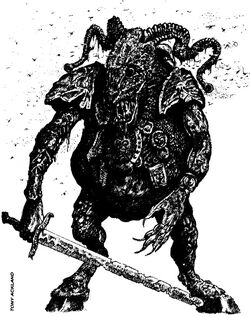
A Pestigor Beastman of Nurgle
Pestigors, the Beastmen of Nurgle, are renowned and feared among their kind. They are a repugnant foe: their hide splits from a hundred lesions, ichor runs from their eyes and mouths, and their fangs and horns blacken with rot. Their spoor harbours foul contagions, and folklore has it that on dark nights they creep from the forests to spoil crops, infect farm-beasts, and sicken peasants by spreading their dung around settlements.[4h]
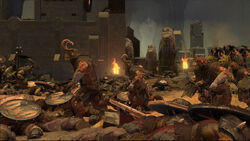
A warband of Pestigors assaulting a group of Orcs as depicted in Total War: Warhammer III.[11]
Though Pestigors are racked by pestilence, disease and malformations they still maintain the morbid vigour that defines all the mortal servants of their patron god. Their fur is usually brown but often hidden beneath dung and other filth, their forms bloated with disease and prominent abscesses and other obvious infections, cultivated to bloom in the shape of the Mark of Nurgle. Highly favoured Pestigors are blessed with the mutation known among them as the "Tears of Nurgle" -- infectious secretions that drip constantly from their ears, eyes, mouth, nose and every other bodily opening. It is also not uncommon for Pestigors who have found great favour with Grandfather Nurgle to become vectors for Nurgle's Rot.[10a]
Unlike most Beastmen, Pestigors often possess only a single horn, much like the Lesser Daemons of the Plague God. Like all Nurglites, mortal and Daemon alike, Pestigors possess enormous fortitude in combat. They often scavenge and wear a surprisingly substantial amount of armour for Beastmen, and are generally more organised and well-disciplined in combat than most of their kind. Other Beastmen such as Gors and Ungors revere Pestigors who have been so blatantly blessed by the Dark Gods, respecting them greatly.[10a]
Pestigors, like their patron god, passionately hate all the mortal and Daemonic servants of Tzeentch and will seek to interfere with the goals of Tzeentchian forces wherever they may be found in the mortal world.[10a]
Some Pestigors have been blessed with the ability to wield magic by their divine patron. Such Pestigor wizards draw upon the Lore of Nurgle to cast their spells like any of the Fly Lord's other sorcerers.[10a]
Clan Pestilens Skaven
Some Skaven of Clan Pestilens, who worship their minor Chaos deity the Horned Rat in his aspect as the spreader of disease and plagues that further the ruin of civilisation, have actually been known to worship Nurgle instead. They see the Plague Lord as a more pure embodiment of disease and decay, though they are careful to disguise their true allegiance in the rituals and language of the Horned Rat's cult for fear of their fellow members of the Pestilent Brotherhood discovering their subterfuge.[8a]
A notable example of this reverence for the Plague Lord among the ratmen can be found in Arch-Prelate Kanker Flett of Under-Middenheim, a Clan Pestilens Plague Monk who is so devoted to the Fly Lord that he has even been blessed with magical abilities drawn from the Lore of Nurgle.[8a]
Chaos Warriors and Champions of Nurgle
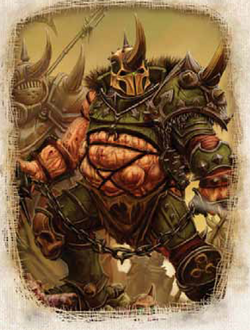
A Chaos Warrior of Nurgle
An unbearable stench heralds the approach of those Chaos Warriors, Champions of Nurgle and Chaos Lords who are among the most mighty mortal servants of the Plague Lord. They are clad in rust-tarnished plate armour, adorned with the heads of defeated foes, and their helmets often bear great, withered horns, emulating those of the Lord of Decay himself.[4h]
Some possess vile mutations -- perhaps a slimy tentacle, or flesh-like translucent jelly in place of their skin that reveals their decaying inner organs. Sometimes the corpulent meat of their bodies spills from the ruins of their armour.[4h]
Yet, despite their decrepit appearance, Nurgle's Chaos Warriors are always deadly fighters, impervious to all forms of pain, who fight on despite the most horrendous wounds.[4h]
Plague Knights and Rot Knights
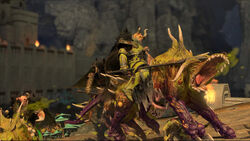
"Rot Knights", an elite unit of Chaos Knights of Nurgle commanded by the Champion of Nurgle Kayzk the Befouled as depicted in Total War: Warhammer III.[11]
Plague Knights represent the elite of those Chaos Knights dedicated to the service of Nurgle. Plague Knights are motivated by a strange and morbid energy; perhaps it is this that enables them to survive wounds that might otherwise slay another Chaos Knight. By all reports, these knights are always infected with all manner of disfiguring diseases, yet they bear their disfigurements openly, and are proud of their dribbling sores and discoloured skin.[9a]
Conversely, some Plague Knights have been known to hide their leprous faces behind bizarre carnival masks with absurdly grinning or grimacing faces. The originally splendid wargear, coats of arms and banners of Plague Knights are always tattered and filthy, like the rags of lepers, and their once-opulent silk or fur cloaks hang from their shoulders like the shrouds of corpses.[9a]
Certain elite Chaos Knights of Nurgle known as "Rot Knights" have been blessed with the Mark of Nurgle and the power to ride the monstrous mutant steeds known as Rot Beasts into battle. Although the Chaos Armour they wear has grown rusty with time, Rot Knights can still take a beating, sacrificing some of their speed for thicker skin with the ability to regenerate even the most mortal of blows.[11]
Chaos Sorcerers of Nurgle
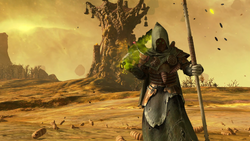
A Chaos Sorcerer of Nurgle, depicted here in Total War: Warhammer III, can master both the Lore of Death and the Dark Magic of the Lore of Nurgle[11].
The Shaman-Sorcerers and seers of the Plague Lord's northern tribes infect those destined for sacrifice with disease before slitting open their bellies and delving into the still-warm morass of contaminated entrails in search of omens of doom or favour from their god. The Chaos Sorcerers of Nurgle are also masters of foul Dark Magic.[4m]
Those Champions of Chaos who offer their souls to the Dark Gods in return for the mastery of forbidden lore achieve great power, at a cost. The raw Winds of Magic are often too much for their sanity to bear. Only the strong-willed can wield such fearsome magic. Sorcerers devoted to Nurgle can inflict suffering and affliction at a whim, becoming masters of both the Lore of Death and the Lore of Nurgle.[4m][11]
Clad in decaying Chaos plate armour and rotten robes, their body host to a hundred ailments, their incantations can cause flesh to blister and skin to slough from muscle. They can enchant worms to infest a victim's organs, consuming him slowly from within, and can rain down boiling bile from the sky. They also have the power to regenerate injured flesh, scabbing over wounds in mockery of Shallya's blessings.[4m]
Chaos Champions, Exalted Champions and Chaos Lords of Nurgle
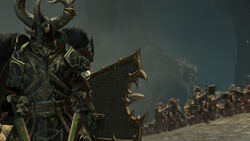
A Chaos Lord of Nurgle, depicted here in Total War: Warhammer III, is a potent leader of the Plague Lord's mortal armies.[11]
Champions of Nurgle and Exalted Champions are Chaos Warriors who have excelled themselves in service to their chosen Chaos God., many eventually becoming Chaos Lords in his service. Those dedicated to Nurgle wear corroded Chaos plate armour and shields inscribed with runes to ward away harm. Some march to war un-helmeted to show off Nurgle's maleficient gifts. The most favoured possess mutated heads and limbs, perhaps those of a giant carrion fly or a horned Plaguebearer. Their weapons sweat necrosis.[4m]
A favourite weapon of Nurglish Champions is the "Death's Head" -- the skull of a foe sealed with wax and filled with slimy filth. The skull shatters on impact; the mixture within dissolves flesh on contact.[4m]
Every Exalted Champion aspires to command an army of Chaos, and they duel heroes of rival barbarian tribes of the Chaos Wastes to this end. The victor takes his opponent's followers as his own. The severed heads of slain foes hang from their belts, the flesh peeling from the skulls. Exalted Champions of Nurgle are particularly keen to best Tzeentch's Chaos Champions, who are contemptuous of Nurgle's love of atrophy and stagnation.[4m]
When a powerful Nurglish Champion manages to unite an army of the northern tribes under his banner, he marches to destroy the civilised realms -- an apostle of plague leading his warbands south to spread decay. Nurgle may grant an all-conquering warlord Daemonhood, the dream of every Chaos Champion.[4m]
Other Nurglish Forces
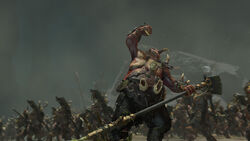
A Plague Ogre found among the mortal armies of Nurgle, as depicted in Total War: Warhammer III.[11]
- Plague Ogres - Plague Ogres are Ogres that have been consumed by Nurgle's Rot and have become powerful, if ever-hungry, servants of the Plague Lord. Plague Ogres serve in the armies of Nurgle as sluggish-yet-durable monstrous infantry, seeking out large enemies with either their giant swords or great axes to slice them to ribbons.[11]
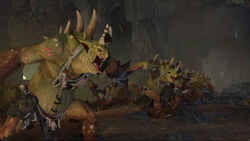
Bile Trolls, as depicted here in Total War: Warhammer III, are perhaps the vilest of the subspecies of Trolls, and unlike most of Nurgle's servants, receive no relief from their constant suffering, as the result of an ancient curse upon their kind.[11]
- Putrid Blightkings - A brotherhood of Champions of Nurgle dedicated to the service of the Plague Lord.
- Bile Trolls - Bile Trolls are Chaos Trolls that have been claimed specifically by Nurgle, though they receive no relief from their suffering like most other servants of the Plague God, due to an ancient curse that was placed upon their kind.
- Plaguebeast of Nurgle - Plaguebeasts of Nurgle are Chaos Spawn touched by the corruption of the Plague Lord.
- Pox-Maggoth - A Pox-Maggoth is a huge, mutated animal gifted with the corruption of Nurgle.
- Toad Dragon - A Toad Dragon is a large, disgusting, frog-like monster used as a mount by the Champion of Nurgle Tamurkhan, the Maggot Lord.
Daemons of Nurgle
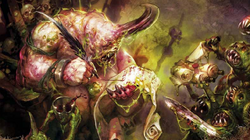
A Plaguebearer of Nurgle dolefully inscribing a list of potential diseases.
The Daemons of Nurgle are truly putrid in their appearance and sickening to look upon. Their flesh pulses with the feverheat of corruption, their innards push through lesions in their putrid skin and their bodies ooze with sticky slime.
Yet in contrast to their hideous appearance, Nurgle's Daemons are cheerful, energetic beings that show a disturbingly friendly demeanour. They are jovial in their work and show great pride in their accomplishments, interpreting the groans of the afflicted as expressions of gratitude justly won by their efforts.
Lesser Daemons
- Nurglings - Nurglings are tiny, mischievous Daemons who are small facsimiles of Nurgle himself. These rotund imps normally appear in large numbers, forming swarms which accompany armies dedicated to Nurgle. Occasionally, very dedicated Chaos Champions of Nurgle will become infested with Nurglings, which will live in gaping wounds and infectious orifices on the Champion's body; when the Champion comes under attack, these little monsters will help defend their "home." When milk sours, crops wither, and fever sweeps the villages of the Empire, peasants often blame the mischief on the Nurglings. These diseased Daemon imps have tiny, putrescent bodies, sharp horns and teeth, and exude a foul-smelling slime from every orifice. They spawn from boils festering in the flabby folds of a Great Unclean One's skin, where they chatter, play, squabble, or suckle on ichor from his ulcers. Their "father" fondles them like favoured pets -- though he often pops one or two into his maw for a quick snack. Sometimes Nurgle sends his Great Unclean Ones to the mortal plane to spread his delicious plagues. While the Greater Daemon ravages the world, some of his Nurglings might fall from him and find themselves stranded among mortals. This is a great opportunity for fun and frolics, and they giggle incessantly as they spread infection. Woe betide anyone who tries to stop their mischief -- Nurglings will swarm over their enemy, scratching and gnawing. Though rarely fatal in itself, the assault marks the beginning of a long, disease-ridden demise. A Great Unclean One often leaves a trail of pus in its wake, pregnant with Nurgling spores. This slime can enter a person's body by contact with the skin, and the spores will gestate within their bowels. When the gestating Nurgling ripens, it struggles its way out into the world through the nearest orifice. The Nurgling will have great affection for its "parent" and bestow upon them generous gifts of poxes.[4n]
- Plague Toads - Plague Toads are horrid, pustulent, squatting creatures that somewhat resemble Squigs and infest sewers during Daemonic invasions. Their wide maws can swallow a Human whole. They are said to be mutated Nurglings, grown fat on filth or even Plaguebearers who have been transformed into their current form due to Grandfather Nurgle's displeasure with them for losing their tally of his diseases inflicted on the mortal world.
- Beasts of Nurgle - These slimy Daemonic beasts resemble huge, pallid slugs, but with two webbed claws at the front, and a mass of paralysing tentacles, teeth, and tongues for a head. Belying their repugnant appearance, they are extremely friendly creatures, bounding towards new "playmates" to welcome them with lavish licks, their tentacles quivering with excitement, and their slugtails wagging, splashing toxic slime everywhere. When their new chum dissolves into a puddle of diseased mush, they seek out another friend. Chaos cultists of Nurgle who have access to forbidden rituals sometimes summon one of these creatures from the Realm of Chaos to guard their secret temples. Beasts of Nurgle are loyal even to mortal followers of Chaos -- unlike most other Daemons they will not (usually) try to eat their summoners, and can be trained. However, cultists must always remember to perform the necessary constraining rituals, lest they be reduced to putrid jelly by the affections of their Beast of Nurgle who is overjoyed at their return.[4n]
- Rot Flies - Rot Flies are colossal Daemonic insects whose appearance is so repugnant that it scars the mind. These vile creatures are the most loathsome of Nurgle's creations. They hatch in the sticky depths of Nurgle's garden in the Realm of Chaos, where the visionary and the loon wander in their dreams.
- Plaguebearers - Plaguebearers are rotting, wasted Daemons of vaguely humanoid size and appearance, with a single burning eye. These vile Lesser Daemons form the rank and file of the Plague Father's pestilent legions. Flies continually buzz around them, therefore making them more difficult to fight through the swarm. The many diseases carried by these Daemons can be used to terrible effect during battle. A Plaguebearer's pallid, sore-infestedflesh stinks of rot, its entrails spilling from its belly like maggots spill from decaying fruit. It lopes on wasted limbs, poison drooling from its fangs, a twisted horn jutting from its forehead. Its single eye, weeping pus, darts about searching for new victims to infect with its plaguesword. The Plaguebearers have almost forgotten the sensation of pain, yet a dull memory of suffering endures; each of these Daemons once had a mortal soul. When a mortal cursed with Nurgle's Rot dies, their soul becomes resurrected as a Plaguebearer in the Land of the Plaguelord, forever condemned to afflict others with the Plague Lord's contagions, and to keep tally of the diseases afflicting the mortal world. On nights when Morrslieb hangs bloated in a starless sky, Empire folk bolt their doors and windows, and hang sprigs of fragrant herbs by the fireplace to ward away the Tainted Ones. If a person should die of illness on such a night, it is whispered that Daemons will take his soul. Indeed, in some remote villages, the mortally sick are left outside to perish lest the Plaguebearers infect the healthy when they come for them.[4n]
- Plague Drones - High-ranking Plaguebearers are known amongst the Daemonic legions of Nurgle as Plague Drones; a title that conveys commendable humility. These overseers of Nurgle's realm ride into the mortal world mounted upon Rot Flies. From their lofty positions, the Plague Drones can properly tally the diseases running rife across the battlefield, as well as swiftly intervene should Nurgle's divine plans meet with heavily-armed mortal resistance.
- Heralds of Nurgle - A Herald of Nurgle is a Plaguebearer who possesses a strength and hardiness that belies their rotten frames, as well as a jovial nature somewhat at odds with the world-weary aspect of their more sober, droning minions.
Greater Daemons
- Daemon Princes of Nurgle - Mortal Champions of Chaos who excel in service to Nurgle, bringing plague and ruin to the civilised lands, are sometimes rewarded by their patron. The unlucky perish from their diseases, or are bequeathed so many mutations that they devolve into mindless Chaos Spawn. A favoured few are brought before Nurgle himself, and if they survive the terrors of his foul garden in the Land of the Plaguelord, he raises them to daemonhood. Their body enlarges. Horns, talons, a tail, and sometimes wings sprout from their changing form. All manner of contagion erupts over their new body, yet they treasure each festering cyst and scabrous blister. Nurgle grants them a Daemonic blade that can split flesh with a mere touch. Daemon Princes of Nurgle often remain at their master's fortress as his devout servants yet sometimes return to their old tribe in the Chaos Wastes. They lead their former companions into battle, feared and revered as a veritable god, yet in reality they are nothing but the eternal slaves of the Plague Lord, doomed to serve his every whim.[4n]
- Great Unclean Ones - Undoubtedly the foulest of the Daemonic servants of the Ruinous Powers, each of these Greater Daemons are shaped in the fashion of Nurgle himself; massive, bloated disease carriers whose decaying flesh bulges with corpulent cancers. Organs spill from its ruptured belly, flapping wetly as it moves. Between the folds of its flab, infestations of Nurglings jabber and squeal. Rotten horns branch from its skull, and a prehensile tongue, fat and pink, worms from its grinning maw. They usually carry a great, rusted blade known as a "plaguesword" and sometimes a flail of skulls into battle, said to be dipped in the foul pus and contagion that lies at the base of Nurgle's throne in the Realm of Chaos. They are the most powerful of Nurgle's Daemons and generally act as the leaders and father figures for the other Daemons of the Plague Lord, epitomising Nurgle's joyful, paternal nature. A Great Unclean One behaves at all times with noisy enthusiasm, even in the thick of battle, guff awing as the flesh of its foes bursts with contagion, and encouraging its minions with booming mirth. These monstrous Daemons occasionally materialise in the mortal world, leading a cancerous host of Lesser Daemons to spread their master's diseases. They enjoy competing amongst themselves to see who can reap the most plague-dead.[4n]
Dance of Death
A Daemonic carnival is said to roam the mortal world on ill-fated nights, particularly in the Empire and Bretonnia. Creaking wheels and the clop of hooves at dusk announces its arrival. From the gloom emerges a procession of wagons drawn by emaciated horses. The once colourful canvasses of these decrepit carts are torn aside, and gangrenous Daemons jump out. Plaguebearers prepare for the performance while Nurglings bicker underfoot. From the largest carriage shuffles a hulking Great Unclean One, the plagued ringleader of the show.[4f]
The Daemons begin their Dance of Death around the chosen settlement. Nurglings sing in falsetto, the Plaguebearers in tenor, and the Great Unclean One provides a deep baritone. They sing of the delicious doom that awaits their victims. As the pageant progresses, the cacophony gets louder, and is joined by the howls of dogs and lowing of cattle from the nearby settlement. Pandemonium seeps into the dreams of the sleeping villagers, while those awake lie paralysed with fear.[4f]
Upon the seventh circuit, the hullabaloo rises to fever pitch. Butter curdles, and milk sours. As a pale sun dawns in a sallow sky, silence falls. Then the Daemons begin the main entertainment, afflicting every known disease upon their screaming audience. By nightfall, only rotten bones tell of the carnival's passing.[4f]
Sources
- 1: Warhammer Armies: Warriors of Chaos (8th Edition)
- 2: Warhammer Fantasy Roleplay 2nd Edition: Tome of Corruption (RPG)
- 3: Liber Chaotica Volume I (Background Book)
- 4: Warhammer Fantasy Roleplay 3rd Edition: Liber Infectus - The Book of Plague (RPG)
- 5 Warhammer Fantasy Roleplay 2nd Edition: Tome of Salvation (RPG)
- 5a: pg. 135
- 6 Total War: Warhammer Guide - Norsca
- 7: Warhammer Armies: Daemons of Chaos (7th Edition)
- 7a: pp. 6, 10-11
- 8: Warhammer Fantasy Roleplay 4th Edition: Middenheim - City of the White Wolf (RPG)
- 8a: pp. 109-110
- 9: Liber Chaotica: Slaanesh Volume II (Background Book)
- 9a: pp. 24-25
- 10: White Dwarf 106 (UK)
- 10a: "Beastmen of Nurgle," pg. 65
- 11: Total War Blog: Thrones of Decay - Introducing Tamurkhan, the Maggot Lord
